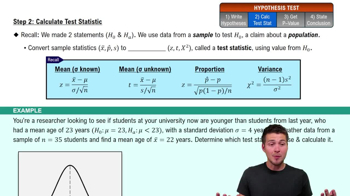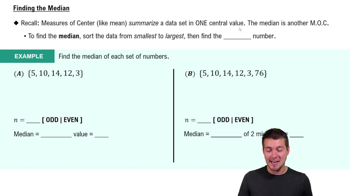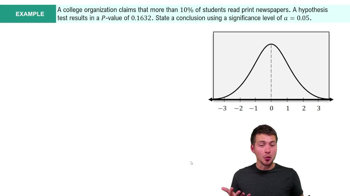What Are We Testing? Refer to the sample data in Exercise 1. Assuming that we use the Wilcoxon rank-sum test with those data, identify the null hypothesis and all possible alternative hypotheses.
Table of contents
- 1. Intro to Stats and Collecting Data1h 14m
- 2. Describing Data with Tables and Graphs1h 55m
- 3. Describing Data Numerically2h 5m
- 4. Probability2h 16m
- 5. Binomial Distribution & Discrete Random Variables3h 6m
- 6. Normal Distribution and Continuous Random Variables2h 11m
- 7. Sampling Distributions & Confidence Intervals: Mean3h 23m
- Sampling Distribution of the Sample Mean and Central Limit Theorem19m
- Distribution of Sample Mean - Excel23m
- Introduction to Confidence Intervals15m
- Confidence Intervals for Population Mean1h 18m
- Determining the Minimum Sample Size Required12m
- Finding Probabilities and T Critical Values - Excel28m
- Confidence Intervals for Population Means - Excel25m
- 8. Sampling Distributions & Confidence Intervals: Proportion1h 12m
- 9. Hypothesis Testing for One Sample3h 29m
- 10. Hypothesis Testing for Two Samples4h 50m
- Two Proportions1h 13m
- Two Proportions Hypothesis Test - Excel28m
- Two Means - Unknown, Unequal Variance1h 3m
- Two Means - Unknown Variances Hypothesis Test - Excel12m
- Two Means - Unknown, Equal Variance15m
- Two Means - Unknown, Equal Variances Hypothesis Test - Excel9m
- Two Means - Known Variance12m
- Two Means - Sigma Known Hypothesis Test - Excel21m
- Two Means - Matched Pairs (Dependent Samples)42m
- Matched Pairs Hypothesis Test - Excel12m
- 11. Correlation1h 6m
- 12. Regression1h 50m
- 13. Chi-Square Tests & Goodness of Fit1h 57m
- 14. ANOVA1h 57m
9. Hypothesis Testing for One Sample
Steps in Hypothesis Testing
Problem 13.5.5
Textbook Question
Using the Kruskal-Wallis Test
In Exercises 5–8, use the Kruskal-Wallis test.
HIC Measurements Use the sample data from Exercise 1 with a 0.05 significance level to test the claim that small, midsize, large, and SUV vehicles have the same median HIC measurement in car crash tests.
 Verified step by step guidance
Verified step by step guidance1
Step 1: Understand the Kruskal-Wallis test. It is a non-parametric test used to compare the medians of three or more independent groups. It does not assume normality and is suitable for ordinal or continuous data.
Step 2: Organize the data. Combine all the HIC measurements from the small, midsize, large, and SUV vehicle groups into a single dataset. Rank all the values from smallest to largest, assigning tied ranks if necessary.
Step 3: Calculate the sum of ranks for each group. For each vehicle type (small, midsize, large, SUV), sum the ranks of the HIC measurements within that group.
Step 4: Compute the Kruskal-Wallis test statistic using the formula: , where N is the total number of observations, Ri is the sum of ranks for group i, and ni is the number of observations in group i.
Step 5: Compare the test statistic (H) to the critical value from the chi-square distribution table with degrees of freedom equal to the number of groups minus 1. If H exceeds the critical value, reject the null hypothesis that the medians are the same across all groups.
 Verified video answer for a similar problem:
Verified video answer for a similar problem:This video solution was recommended by our tutors as helpful for the problem above
Video duration:
7mPlay a video:
Was this helpful?
Key Concepts
Here are the essential concepts you must grasp in order to answer the question correctly.
Kruskal-Wallis Test
The Kruskal-Wallis test is a non-parametric statistical method used to determine if there are statistically significant differences between the medians of three or more independent groups. It is an extension of the Mann-Whitney U test and is particularly useful when the assumptions of ANOVA (such as normality) are not met. The test ranks all data points from all groups together and compares the sum of ranks between groups.
Recommended video:
Guided course

Step 2: Calculate Test Statistic
Median
The median is a measure of central tendency that represents the middle value of a dataset when it is ordered from least to greatest. Unlike the mean, the median is less affected by outliers and skewed data, making it a robust measure for understanding the central location of a dataset. In the context of the Kruskal-Wallis test, the median is used to assess whether different groups have similar central values.
Recommended video:
Guided course

Calculating the Median
Significance Level
The significance level, often denoted as alpha (α), is the threshold used to determine whether to reject the null hypothesis in hypothesis testing. A common significance level is 0.05, which indicates a 5% risk of concluding that a difference exists when there is none. In the context of the Kruskal-Wallis test, if the p-value is less than 0.05, it suggests that at least one group has a different median HIC measurement, leading to the rejection of the null hypothesis.
Recommended video:
Guided course

Step 4: State Conclusion Example 4

 6:21m
6:21mWatch next
Master Step 1: Write Hypotheses with a bite sized video explanation from Patrick
Start learningRelated Videos
Related Practice
